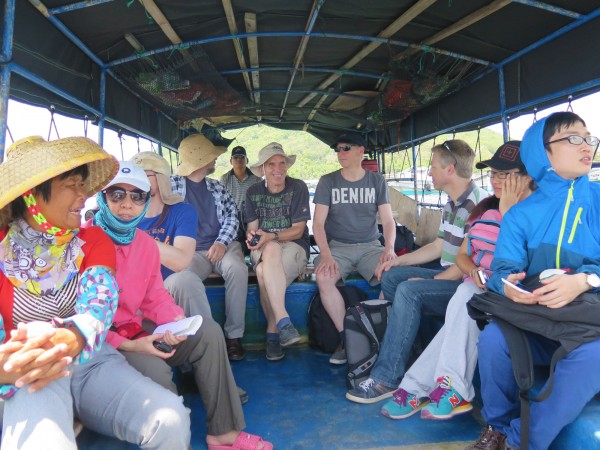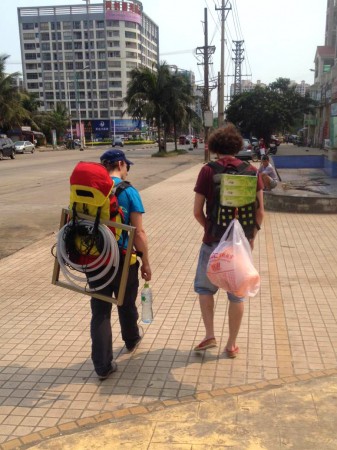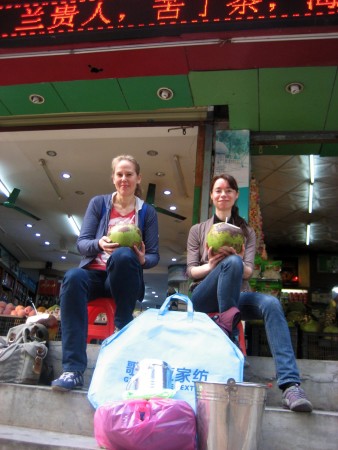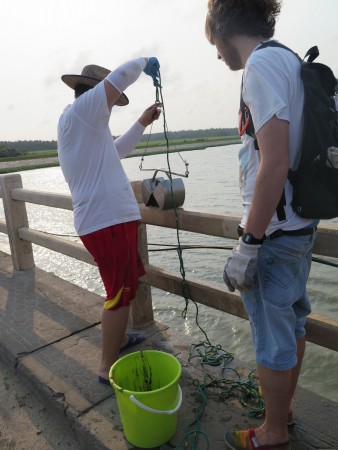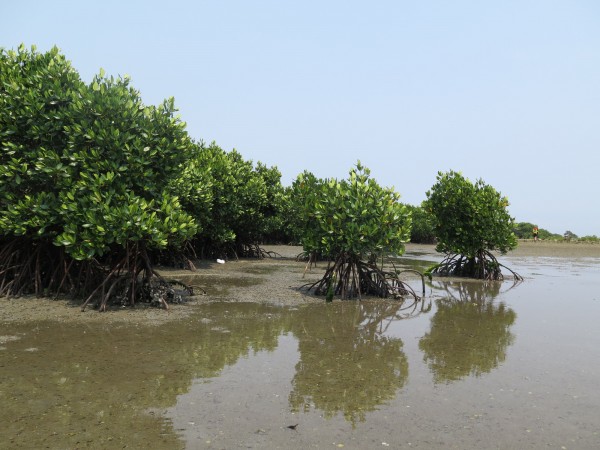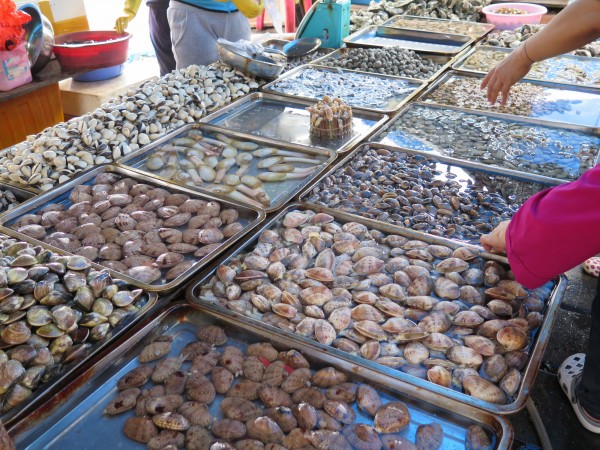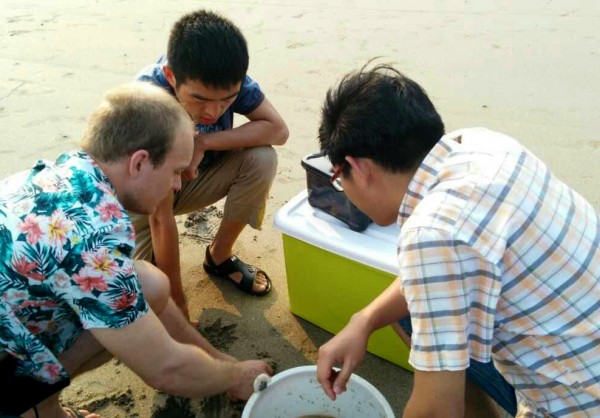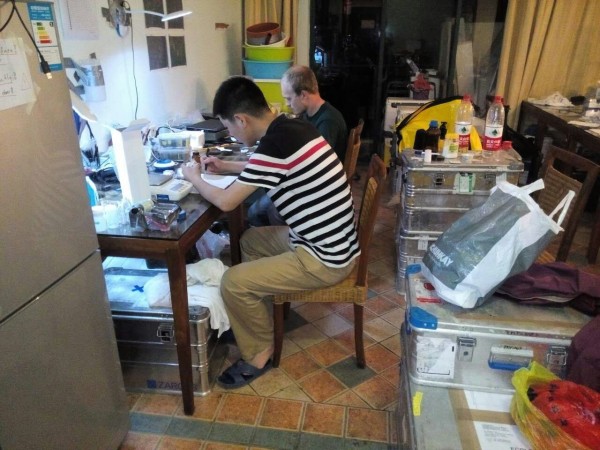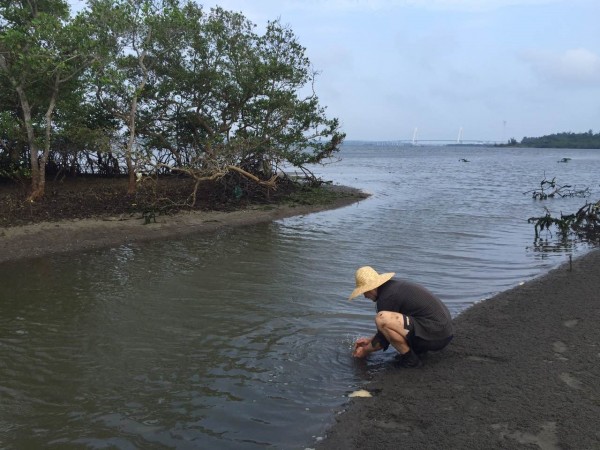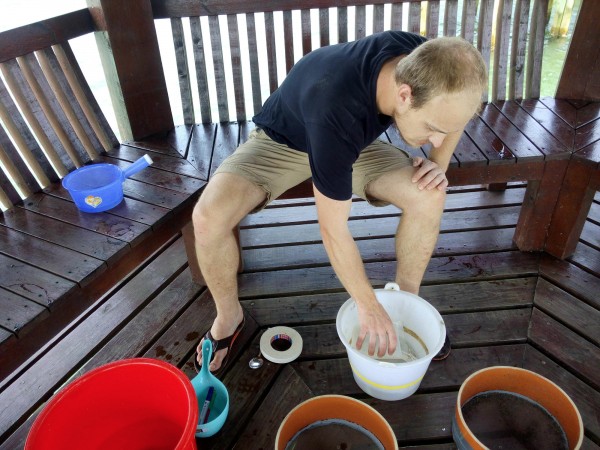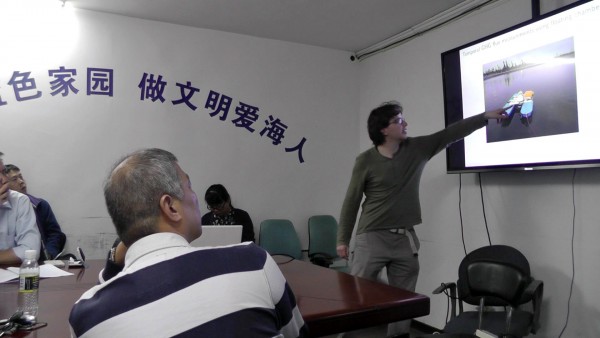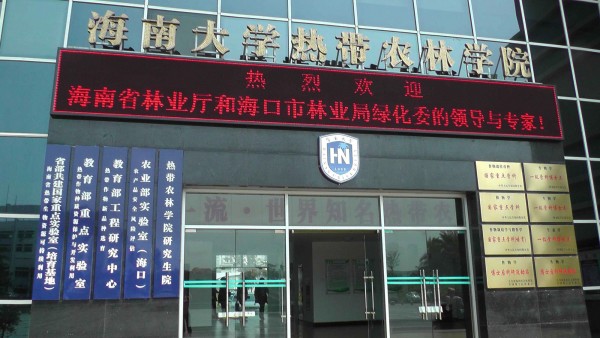Visiting the study sites in Hainan during the kick-off meeting
in June-July 2015 | Photo: I. Nordhaus
Tropical coast are vulnerable to global environmental change and anthropogenic impacts such as intensified aquaculture or expanded tourism. The interdisciplinary Sino-German project ECOLOC (Environmental change affecting COastal ecosystems of tropical China during the Anthropocene: Landward vs. OCeanic influence) aims at understanding the natural and anthropogenic factors controlling coastal ecosystems of Hainan, China, and the response of these coastal habitats and their organisms.
6.3.17
Finally! On 6th of March, we travelled to Haikou to start our second field campaign for the ECOLOC project. Most of the samples from the last field work were already processed and analyzed. Ideas for publications took shape or were already put down on paper. So it was time to get new material to work on, to deepen our studies and to gain new insights in the coastal ecosystems of Hainan.
This time, it was much easier – literally. Instead of 1200 kg of equipment like last year, we only had 700 kg of equipment to transport to China. A part of our equipment from the last field campaign, including a drying oven, two fridge-freezers and many boxes, was still stored at the Hainan University (HNU) in Haikou. One of the first tasks after arriving in Haikou and getting adapted to the tropical climate was to check this equipment and to sort out what is needed for the field work this time. This was a good way to overcome the jetlag. And an easy one, because the boxes were already properly labeled last year.
Another important step was the meeting with our Chinese cooperation partners to discuss the first results and talk about the plans for the upcoming field work. There were very interesting short presentations about the following topics:
- Marco Drews discussed the question “Can well-managed aquaculture reduce the anthropogenic carbon footprint?”.
- Esther Thomsen presented “Seagrass under stress - Responses to aquaculture effluent input”.
- Inga Nordhaus and Marlene Cordts talked about the “Diversity and community composition of Hainan´s coastal benthic invertebrates related to the dispersal of land-derived pollutants”.
- Zhao Hongwei explained the “Analyses of antibiotics and the relevant resistence genes in Dongzhai Mangrove”.
In this way, everyone was informed about the current status of our work. But to finally start our work in the field, we still needed more material. To be more precise: several chemicals to calibrate measuring instruments or stabilize samples, fertilizer for a seagrass study and so on. Thanks to our Chinese cooperation partners, these things could be ordered in Haikou and were directly sent to the Hainan University.
After a few days of preparation, everything was ready and we could transport all the necessary equipment to Wenchang City which is located about 60 km southeast of Haikou. Our hotel in Wenchang was the starting point for the field work in the next weeks.
Text by Franziska Günther, ZMT
8.5.16
Many photos from the sampling during our field campaign were already presented in this blog (see below). I will give you a brief insight into the work that has to be done afterwards. We handled many various sediment samples taken from riverbeds as well as shorelines.
One part of the samples could be prepared in a very easy way: First of all, we had to estimate the volume of each sediment sample using measuring cylinders. Then, we washed and sieved the sediment using a mesh size of 500 µm. Finally, the sediment was put in sample bottles and labelled properly. Because we needed a lot of water for the washing step, we liked to directly work at the Bai Jin coast.
Other sediment samples were processed in the following way: One sediment sample had to be divided in three subsamples for later analyses. One subsample was taken using a syringe without needle; the second subsample was taken with a small scoop and directly transferred into a sample bottle for subsequent investigations. The last subsample was also taken with a scoop, weighed and put in the oven for three days to determine the water content.
On a normal day, we left the base camp at 7 am to collect samples, came back at 10 pm and, then, started with the sample processing.
Text by Kailin Mao, PhD candidate at Hainan University
5.5.16
Here are a few impressions from our work in the mangroves. We took sediments and water samples for our investigations. Based on the collected samples, we want to analyze the water content, grain size, carbon and nitrogen as well as organic pollutants. Today, it was not so easy to get to our sampling sites. We had to walk a lot carrying all our equipment. Work was quite challenging, because we were in the mud and water all the time. Nevertheless, the mood in our small working group was very good and we could collect many samples which had to be carried, too. At the end of the day, we all were loaded like pack mules, tired – but satisfied.
Text and Photos by Zhang Yu, PhD candidate at Hainan University
3.5.16
We are ready to start to our “base camp” in Wenchang and all of us were very excited about this field campaign.
In the beginning, we had some troubles renting boats which could really affect our sampling activity. However, both, the Chinese as well as the German participants, tried very hard to find a way to solve the problem. Finally, we decided to go to the sample stations first which are accessible by car and where boats were not needed. The following photos show some of our sample stations.
On April 7th, we visited our first sample station which is directly under the Wenchang Education-Bridge. We called this station WE02 according to WEnchang and the location in our transect (02). We drove to four other stations for sampling – directly from the bridge or from the river side. The collected sediment samples were packed and labelled properly.
During the sampling, we cooperated well with each other. After finishing the first sample stations in Bamen Bay area, we had to face the already familiar problem - taking a boat. As German scientists were not allowed to get on a boat, Chinese scientists tried to take samples for them. After searching and checking the information, we finally rented a boat in Hengshan dock and planned to start on the next day. Before starting, the German group members Marvin and Sebastian showed us on the beach how to sample correctly and mentioned all important details.
On April 10th, we started sampling in the Bamen bay using a boat. We successfully collected sediment samples at different stations. But then we ran into some trouble. With the low tide, the water was getting shallower and our boat stranded on solid ground. All men had to push or pull the boat in the water again. We tried to find a way to leave this area, because it was getting dark and some of our members got hurt in the water. However, we could not go back using the same way, and we finally stopped at a dock along the river.
In the next days, we sampled many different stations north and south of the Qinlan Bridge always carefully observing the tide. In one place, we could not use our anchor because of all the fishing nets and ropes. In another place, we had to work very carefully due to many other ships and boats in this area. Some people were also working under water which could be quite dangerous, because we used heavy instruments such as a grab to take sediment samples from the ground. But we managed the tricky situations, worked carefully and everything went well.
On the last sample station, we could only take water samples due to heavy wind and waves. After finishing sampling in Bamen Bay and preparing the samples in our field laboratory in Wenchang, some of us had to go back to Haikou. It was really an impressive experience for us to work in the ECOLOC group. Many thanks go to our supervisors Prof. Xiaoping Diao, Prof. Fei Yang, Dr. Hailong Zhou, Dr. Hongwei Zhao and Dr. Yan Wang for supporting us during the sampling campaign.
Text by Ping Li and Liu Chuandong
26.4.16
I want to show you how a typical day during field work can look like. I hope you enjoy my pictures.
Photo 1: Usually, there is a discussion on the previous evening about the plans for the next day. Where do you want to go? What do you want to do? What do you need?
Photo 2: Then, we put our equipment on the rented boat and set off to the study sites where samples shall be taken. In the foreground of the photo you can already see some sediment samples.
Photo 3: Using a grab we take benthic samples in the Changpi area.
Photo 4: On the boat, we start to prepare our new samples by sieving. At the same time, the exact coordinates of the collected samples must be writen down.
Photo 5: After coming back, we continue to sieve and filter samples.
Photo 6: This is one of our samples taken from in a coral reef area.
Photo 7: Finally, we come back to the hotel. But this doesn’t mean we’re done with work. In our “field” laboratory in the hotel, we sort and prepare benthic organisms until midnight and perhaps even later.
The very next day, however, the team is back to work on the boats for further sampling.
Text and photos by Cuixing Ye, PhD candidate at Hainan University
22.4.16
I want to share a few impressions from my last stay in the field for the Sino-German ECOLOC project. I organized a lot of equipment for the subproject 5 in Haikou, for example tubes and O-ring seals, and had to check several stores to find the suitable pieces. After getting everything, we tried to put as much as possible in the bus that took us to the aquaculture company where the long-time trace gas measurements should be done. Although we tried to use every centimeter, our German colleagues seem to enjoy the trip.
The German PhD candidate was going for a walk with the Ferry Box, a water flow through system with diverse sensors, which is used to continuously measure different water parameters (such as temperature, oxygen or pH). With about 20 kg this Ferry Box is not easily transported over long distances. Therefore, a wheelbarrow can be very helpful.
After a long day of sampling in the field and sample preparation in our “field” laboratory, we used the last hours of the day to relax a little bit.
Qiu Liguo, PhD candidate at the Hainan University
21.4.16
Our main goal during this field campaign was to measure trace gases in an aquaculture facility for as long as possible to better understand eutrophication in coastal ecosystems.
Due to the high engagement of our Chinese colleagues (special thanks to Dr. Hongwei Zhao and Qiu Liguo) we have finally found an aquaculture where we can install our scientific equipment. The company is felt like being located in the middle of nowhere and it takes about an hour by car (from our Wenchang “base camp” hotel) passing goats and travelling on never ending field paths. The first trip was an adventurous journey transporting as much equipment as possible in the small bus of the company.
Even though there are limitations in communication on both sides, the employees feel interested in our work and supported us wholeheartedly. Thank you so much (非常感谢).
Our FTIR (short and easy for ‘Fourier transform infrared spectroscopy’) spectrometer, a black box we like to call ‘Bernd’, is now placed in a neat small house. Using this instrument, we detect climate relevant trace gases from the headspace of an equilibrator, that we are used to call small shower here. These showers occur in intervals of ten minutes for 24/7.
In order to keep the gas lines and cables as short as possible, we need to pump water from a pond that is about 100 m away. We can’t place ‘Bernd’ closer to the pond, because he prefers a dry place and uninterrupted power supply. There are still some things needed to be fixed, especially getting a gas bottle which is still stuck in the inland customs. But we are confident that all the problems will be solved soon.
Text by Marco Drews, ZMT
10.4.16
After most of our group members have arranged themselves in the “base camp” hotel, it was time to take care about our small field laboratory that we established in one of the hotel rooms. Our equipment was finally released from customs and we could arrange everything in our new field laboratory including an oven, fridges, a balance, a filtration system and a microscope. We are quite happy to announce that we are ready to start our work. Now we just need the official work permission from the SOA which should arrive after the weekend on the 4th of April. At the beginning of April, the Chinese have the Qingming festival, also known as Tomb-Sweeping day, a time to remember and honor the ancestors.
We used the waiting time to visit of the local market and had a look at the wide variety of mussels, gastropods, crabs, shrimps, sea stars and fish collected in the coastal waters. This was also a good opportunity for the students to test their knowledge and identify the different species. As promised, we happily received the research permission from SOA. Now we are allowed to start with our field work.
We visited Changqi, one of our sampling sites, that is located south of the Wenchang estuary. There, we like to work along transects starting behind the aquaculture ponds. These transects include the mangrove belt, the tidal flats with seagrasses and a rich benthic fauna, and the corals at the seaward edge.
By car, we could easily drive to different locations and sample rivers flowing into the Bamen Bay – one of our study sites. Together with the Chinese students, we collected sediment samples to investigate the benthic community and the concentrations of inorganic and organic pollutants. After collecting samples in the field, we spent hours in our field laboratory to process the samples. Until late in the night, sediment samples were sieved, while other samples had to be weighed and dried.
Text by Inga Nordhaus, ZMT
29.3.16
After about 15 hours in the air and 9 hours at the airports, we arrived in Haikou at Tuesday night. Our group was continuously growing during travelling from Germany to China. Inga, Hella, Marco, Timothy and me started together from Bremen, we met Larissa, Sebastian and Marvin at the Frankfurt airport and Tim at the Beijing airport. Finally, we met Franziska at the Haikou Airport. We directly realized that we are in the tropics now. Temperature rose from 8 °C in Bremen to 28°C in Haikou. During the next weeks and month we will stay on Hainan Island to take samples for the ECOLOC project in cooperation with the Hainan University (HNU) and the Hainan Academy for Ocean and Fisheries Sciences (HAOFS).
The first days at the HNU and HAOFS already started with a big surprise. Our whole equipment that was sent from Germany to China is stuck in the customs for at least two more weeks! Fortunately, most of us came prepared for cases like this and already put some scientific equipment such as filters, measuring probes or sample bags in their own luggage. Even my own bags contained more scientific material than private stuff. That’s what you call a dedicated scientist – always prepared for the worst case.
Nevertheless, we had to develop back-up plans how to proceed without our 1200 kg of equipment. This was possible due to the kind support from all partners here in Hainan. Especially, the PhD candidates of HNU and HAOFS, first and foremost PhD candidate Li Ping from the HNU, spend most of their time supporting us and organizing new equipment. Here, I would like to thank her again for her effort and time. It was quite a lot of work to do. One part of our German group was busy translating orders from English to Chinese and vice versa to find adequate equipment which we needed to start sampling as soon as possible. We had to buy unusual things such as car batteries or cooling boxes. You have to imagine the expression on the faces if the only Europeans in town go to a small fishery shop and buy all available cooling boxes even those in the storage rooms.
Afterwards they convince the owner to bring them to the hotel in his van, because they do not fit into a normal taxi. We also had to find many replacements for our equipment. Instead of scientific weighing bowls, we use paper cups you can easily buy in the supermarkets. Some instruments such as sediment graps to collect sediment samples from the bottom of the water, we had to rent from the HNU or HAOFS. Meanwhile, the other part of the German group already travelled to Wenchang setting up our “base camp” and a small field laboratory. They bought freezers and fridges, tubes and already checked which boats might be useful for the sampling and where they could be rent. Of course, we can hardly wait to go to the field and hoping we can follow to Wenchang on Wednesday and start sampling on Thursday.
By the way, it is an amazing experience to communicate with the locals without even speaking Chinese. We started to learn basic words such as 你好 “Nǐ hǎo” (Hello) and 謝謝 “Xiè xie” (Thank you). Let’s see how far we can improve our Chinese until the end of the field work.
Text by Esther Thomsen, ZMT
11.3.16
At the beginning of this year, our preparations for the first big field campaign in Hainan, China went into the hot phase. Of course, the first preparations started much earlier. In June-July 2015, the German and Chinese scientists met in Hainan and visited the different study sites there. We discussed ideas as well as research questions and got to know each other better. A very good opportunity to talk in a more private atmosphere is the time during dinner when everyone sits at these wonderful round tables, enjoying the food and practicing their chopstick abilities. In total, our group consists of five German and four Chinese research institutes as well as universities (here you can check all the participants of the ECOLOC project). In several meetings, we developed a first work schedule for our field campaign. I have to admit we were very ambitious and set up a rather tight timetable. Of course, we all knew that there are always delays or changes in a plan. But a goal without a plan is just a wish – as Antoine de Saint-Exupéry already pointed out. And we all had a big goal – a successful field campaign in April-May 2016. Therefore, we had to get a work permission by the State Oceanic Administration, also called SOA, which is responsible for the organization of scientific research in coastal and sea areas in China. Then, we had to prepare the scientific equipment for the field campaign. Sounds easy, but it was quite a task. A lot of things had to be ordered or prepared. Almost every day new packages arrived at the ZMT in Bremen filled with consumable materials such as bottles, filters or sampling bags for the field campaign. Our student helpers spend hours and days in the labs to clean these bottles and bags to avoid any contamination. Until the last days, instruments were calibrated and assembled. I myself, as coordinator of this project, were less involved in the cleaning and calibration procedures, but I had to combine and write various packing lists completed over 44 pages - in German, English as well as Chinese. One page for each box. In total, we prepared 44 boxes with almost 1200 kg of equipment.
In comparison to this, booking flights and finding suitable accommodations in Haikou were no big challenges any more. We also got a lot of support in organizing everything in Haikou by our Chinese colleagues. They took care about the hotels and meeting rooms. They also bought chemicals and gas bottles for us we would never be able to transport by air. Many thanks to them!
Text by Franziska Günther, ZMT
Dr. Franziska Günther & Esther Thomsen, WG Ecological Biogeochemistry





